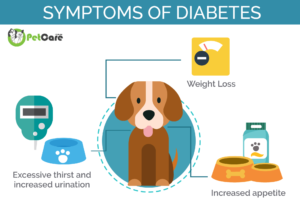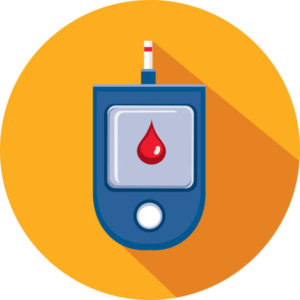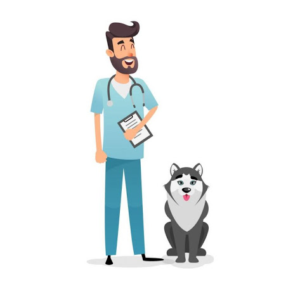What is diabetes mellitus and why is it harmful?

Diabetes mellitus has many symptoms with the most common client concerns being excessive urination and thirst. Diabetes mellitus is a serious medical condition where your pet cannot control blood sugar levels due to problems with insulin production or function. Glucose is the main energy source that body cells need to operate efficiently. Your dog’s digestive system breaks food down into various parts, including glucose, which then enters the bloodstream.
Insulin, which is made by the pancreas, is a hormone that acts as the “key” for cells to absorb glucose from the bloodstream. When insulin levels are too low or when the body is resistant to insulin, cell “doors” remain closed and glucose stays in the bloodstream where cells cannot utilize it. The dog’s cells tell the body they are starving, even though there may be high levels of unused glucose in the bloodstream. Because of the vast amounts of glucose in the body, the dog urinates more often and drinks excessively to make up for the increased water loss.
Untreated, the cells will begin to utilize other, less desirable fuel sources since glucose is not available. Without treatment, severe problems such as liver and kidney damage and even death can occur. The good news is that diabetes is a treatable condition, but does require lifelong attention.
There are two main types of diabetes mellitus:
- Type I diabetes mellitus can be regulated by insulin injections (insulin dependent). This form of diabetes is most closely related to the human form of diabetes seen in children where there is a very low or no production of insulin by the pancreas.
- Type II diabetes mellitus is non-insulin dependent and is similar to the human form of diabetes that develops in adult humans. There is a high or normal initial blood insulin level but the body is resistant to the function of insulin. Insulin, diet and other medications may be used to treat this form of diabetes mellitus.
- Diabetes in dogs is usually type I, which is when the pancreas produces little or no insulin. These pets will need insulin injections for life.
How will the doctor treat my diabetic dog?
After confirming the diagnosis and determining if your dog has any other health concerns, your doctor will most likely begin treatment with a diet change and insulin injections. Regulating a diabetic pet can be a challenge for a veterinarian as every pet responds to insulin differently.
Frequent trips to your doctor will be needed to assess how your pet is doing and if any modifications to the treatment plan are needed. Several blood tests may be run at weekly intervals for many weeks to monitor how your dog’s blood glucose levels are responding to the prescribed therapy.
The goal of insulin therapy is to keep the blood glucose level below 300 mg/dL, with the lowest point being 100 mg/dL and your dog’s level may be higher or lower. The first few weeks will be a learning curve for both you and your dog and overall care will be more expensive. Your veterinary team can provide you with a treatment plan to set your expectations.
What do I need to do?
After a proper insulin dose is decided on, your dog may only need a few trips to the hospital a year to reassess the treatment regimen. An important part of treatment is consistency in timing of feeding and medication administration. Develop a method that works well for you and your family to monitor when injections were given, how much your dog ate, any abnormal behavior, etc.
Proper feeding is a very important component in the management of canine diabetes. The optimum diet for a diabetic pet is one that is low in fat and high in fiber. Many newly diagnosed diabetic pets are overweight, which can increase the amount of insulin needed. Eating a low-fat diet helps with weight reduction and the high fiber content adds complex carbohydrates that are digested more slowly to help reduce the sharp changes in the blood glucose level. The addition of the fiber in the diet also helps the pet feel full, which aids in weight management. Be sure to speak to your doctor about any other foods or treats to assure compatibility.
Diabetics must be fed as prescribed by your doctor to coincide with the insulin administration. Do not administer insulin if the pet does not eat. Otherwise, the blood sugar could drop dangerously low. Your doctor will go over with you how to properly give your dog an insulin injection and suggest ways to practice before trying your skills on your dog.
Insulin is stored in the refrigerator. Before being withdrawn from the vial, insulin should be mixed by gently rolling the bottle between your palms. Do not shake vigorously, as this can damage the proteins and cause the insulin to be ineffective. Insulin is administered under your dog’s skin (not a vein or muscle). Pinch and pull up the skin to form a tent over your dog’s shoulder. Give the injection in the middle of the tent. Because the needle is very short and narrow, few dogs even notice the injection. Most dogs adjust easily to the injections and will even remind their owners that it is time for their injection and their food. Caring for a diabetic pet will place some restrictions on your ability to spend time away from home. Your pet must be given insulin or other medications, fed properly and observed every day after meals. Thus, it is important to plan ahead so the diabetic pet can be properly monitored.
Home testing kits available

AlphaTRAKTM glucometers are available for purchase and use at home. Home glucose monitoring can be an important part of long-term management of diabetic dogs after stabilization, their insulin type and dosage have been established. You can monitor blood glucose readings periodically (daily, weekly, etc.) or you can perform home glucose curves. If you choose to utilize AlphaTRAK, please partner with your veterinarian to learn how to use AlphaTRAK and establish a regular visit schedule for your dog.
What should I be aware of after insulin therapy is initiated?
Diabetic dogs do need to be carefully monitored for signsof hypoglycemia (low blood sugar) such as vomiting, sluggishness, difficulty seeing, disorientation, excessive salivation, and in very advanced cases, seizures. Eventually most diabetic dogs will have a hypoglycemic event and knowing how to handle the situation will lower the stress levels for you and your dog. Talk with your doctor about methods for quickly boosting your pet’s glucose levels during these episodes. Determine where your local emergency hospital is in case your pet needs medical attention after hours.

As always, if you have any questions or concerns, please contact your hospital. Never adjust your pet’s insulin dose without first consulting your veterinarian.